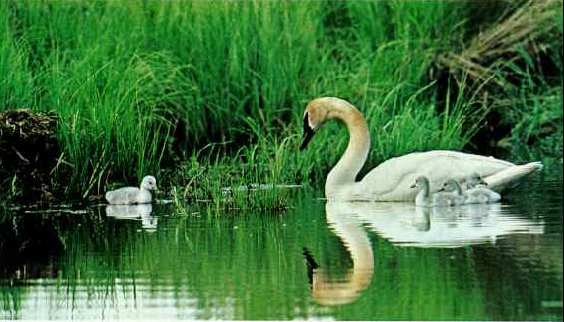
Trumpeters flocking to the shore
of Lonesome Lake.
Photo:
© Art Wolfe, National Geographic Magazine,
October 1985
The Trumpeter Swan, Cygnus buccinator, is the largest native
North American bird,
if measured in terms of weight and length, and is (on average) the
largest waterfowl species on earth. Males typically measure from
145–163 cm (57–64 inches) and weigh 11.8 kg (26 lb);
females typically range from 139–150 cm (55–60 inches)
and weigh 10 kg (22 lb).
Exceptionally large male Trumpeters can reach a length of 183 cm
(72 inches),
a wingspan of 3 meters (almost 10 ft) and a weight of 17.4 kg (38
lb).
The Trumpeter Swan is closely related to the Whooper
Swan of Eurasia,
and even has been considered the same species by some authorities.

Present
migration
routes
Photo:
© Art Wolfe, National Geographic Magazine,
October 1985
Their breeding habitat
is large shallow ponds and wide slow rivers in northwestern and
central
North America, with the largest numbers of breeding pairs found
in Alaska.
Natural populations of these swans migrate
to and from the Pacific coast and portions of the United States,
flying in V-shaped flocks. Released populations are mostly non-migratory.
In winter, they may
eat crop remnants in agricultural fields,
but more
commonly they feed while swimming.
These birds have white plumage with a long neck, a black bill subtly
marked with salmon-pink
along the mouthline, and short black legs.
The females become flightless shortly after the young hatch;
the males go through this process about a month later when the females
have completed their moult.

Only
hours old, a cygnes surveys its surroundings from a lily pad in
Alaska's Swan Creek.
In a single summer it will grow to an stounding 15 to 20 pounds.
Photo:
© Art Wolfe, National Geographic Magazine,
October 1985
The female lays 8
to 17 eggs in a mound of plant material on a small island,
a beaver or muskrat lodge, or a floating platform.
The same location may be used for several years.
The eggs average 73 mm (2.9 inches) wide, 113.5 mm (4.5 inches)
long,
and weigh about 320 grams (11.3 oz).
The incubation period is 32 to 37 days.
These birds often mate for life, and both parents will participate
in incubation and brooding.
The young are able to swim within two days and usually are capable
of feeding themselves
after at most two weeks. The fledging stage is reached at 3 to 4
months.
Predators of Trumpeter
Swan eggs include Common Raven
(Corvus corax), Common Raccoon (Procyon lotor), Wolverine
(Gulo gulo), American Black Bear (Ursus americanus), Brown
Bear (Ursus arctos), Coyote (Canis latrans), Gray
Wolf (Canis lupus) and Northern River Otter (Lontra canadensis).
Larger cygnets and nesting adults are preyed on by Golden Eagle
(Aquila chrysaetos), Bobcat (Lynx rufus), Red
Fox (Vulpes vulpes) and Coyote. Few predators, apart from the
Bobcat and possibly the Golden Eagle, are capable of taking adults
when they are not nesting.

One
of the parents stands guard in Kenai National Wildlife Refuge.
Photo:
© Art Wolfe, National Geographic Magazine,
October 1985
This bird was named
for its trumpet-like honk which some compare to the sound of a French
horn.
In the 1800s and early
1900s, the Trumpeter Swan was hunted heavily,
both as game and a source of feathers.
These birds once bred in North America from northwestern Indiana
west to Oregon in the U.S.,
and in Canada from James Bay to the Yukon, but their comparatively
small numbers in the
southern part of their range were reduced to near zero by the mid-twentieth
century.
Many thousands survived in the core range in Canada and Alaska,
however, where populations
have since rebounded. Efforts to reintroduce this bird into other
parts of its original range,
and to introduce it elsewhere, have had only modest success, as
suitable habitats have
dwindled
and the released birds do not undertake migrations.

Graceful
flotilla of trumpeters cruises Lonesome Lake, a wintering ground
in Britsh Columbia.
Photo:
© Art Wolfe, National Geographic Magazine,
October 1985
Text (except to pictures) : http://en.wikipedia.org












